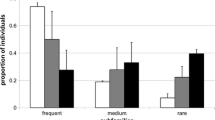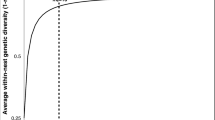Summary
Three experiments were performed to determine whether brood care in honey bee colonies is influenced by colony genetic structure and by social context. In experiment 1, there were significant genotypic biases in the relative likelihood of rearing queens or workers, based on observations of individually labeled workers of known age belonging to two visually distinguishable subfamilies. In experiment 2, no genotypic biases in the relative likelihood of rearing drones or workers was detected, in the same colonies that were used in experiment 1. In experiment 3, there again were significant genotypic differences in the likelihood of rearing queens or workers, based on electrophoretic analyses of workers from a set of colonies with allozyme subfamily markers. There also was an overall significant trend for colonies to show greater subfamily differences in queen rearing when the queens were sisters (half- and super-sisters) rather than unrelated, but these differences were not consistent from trial to trial for some colonies. Results of experiments 1 and 3 demonstrate genotypic differences in queen rearing, which has been reported previously based on more limited behavioral observations. Results from all three experiments suggest that genotypic differences in brood care are influenced by social context and may be more pronounced when workers have a theoretical opportunity to practice nepotism. Finally, we failed to detect persistent interindividual differences in bees from either subfamily in the tendency to rear queen brood, using two different statistical tests. This indicates that the probability of queen rearing was influenced by genotypic differences but not by the effect of prior queen-rearing experience. These results suggest that subfamilies within a colony can specialize on a particular task, such as queen rearing, without individual workers performing that task for extended periods of time.
Similar content being viewed by others
References
Alexander RD (1990) Epigenetic rules and Darwinian algorithms: the adaptive study of learning and development. Ethol Sociobiol 11:241–303
Alexander RD (1991) Social learning and kin recognition. Ethol Sociobiol 12:387–399
Breed MD, Butler L, Stiller T (1985) Kin discrimination by worker honey bees in genetically mixed groups. Proc Natl Acad Sci 82:3058–3061
Brouwers, EVM, Ebert, R, Beetsma, J (1987) Behavioural and physiological aspects of nurse bees in relation to the composition of larval food during caste differentiation in the honeybee. J Apicult Res 26:11–23
Calderone NW (1993) Genotypic effects on the response of worker honey bees, Apis mellifera, to the colony environment. Anim Behav 46:403–404
Calderone NW, Page RE (1992) Effects of interactions among genotypically diverse nestmates on task specialization by foraging honey bees (Apis mellifera). Behav Ecol Sociobiol 30:219–226
Calabi P, Traniello JFA (1989) Behavioral flexibility in age castes of the ant Pheidole dentata. J Insect Behav 2:663–677
Carlin NF, Reeve HK, Cover SP (in press) Kin discrimination and division of labour among matrilines in the polygynous carpenter ant, Camponotus planatus. In: Keller L (ed) Queen number and sociality in insects, Oxford University Press, Oxford, pp 362–401
Crozier RH, Page RE (1985) On being the right size: male contributions and multiple mating in social Hymenoptera. Behav Ecol Sociobiol 18:105–115
Evers CA, Seeley TD (1986) Kin discrimination and aggression in honey bee colonies with laying workers. Anim Behav 34:924–944
Fondrk MK, RE Page, Hunt GE (1993) Paternity analysis of worker honeybees using random amplified polymorphic DNA. Naturwissenschaften 80:226–231
Furgala B, Boch R (1961) Distribution of bees on brood. Bee World 42:200–202
Frumhoff PC, Schneider S (1987) The social consequences of honey bee polyandry: the effects of kinship on worker interactions within colonies. Anim Behav 35:255–262
Getz WM (1991) The honey bee as a model kin recognition system. In: Hepper PG (ed) Kin recognition. Cambridge University Press, Cambridge
Getz WM, Smith KB (1983) Genetic kin recognition: honey bees discriminate between full and half-sisters. Nature 302:147–148
Getz WM, Smith KB (1986) Honey bee kin recognition: learning self and nestmate phenotypes. Anim Behav 34:1617–1626
Getz WM, Brückner D, Smith KB (1986) Conditioning honeybees to discriminate between heritable odors from full and half sisters. J Comp Physiol A 159:251–256
Grafen A (1990) Do animals really recognize kin? Anim Behav 39:42–54
Guzman-Novoa E, Page RE (in press) Genetic dominance and worker interactions affect honey bee colony defense. Behav Ecol
Hamilton WD (1964) The genetical theory of social behavior, I and II. J Theor Biol 7:1–16, 17–52
Hillesheim E, Koeniger N, Moritz R (1989) Colony performance in honeybees depends on the proportion of subordinate and dominant workers. Behav Ecol Sociobiol 24:291–296
Herbert PDN, Beaton MJ (1989) Methodologies for allozyme analysis using cellulose acetate electrophoresis. Helena Laboratories, Beaumont, TX
Hillesheim E, Koeniger N, Moritz RFA (1989) Colony performance in honeybees (Apis mellifera capensis Esch.) depends on the proportion of subordinate and dominant workers. Behav Ecol Sociobiol 24:291–296
Holmes WG, Sherman PW (1982) The ontogeny of kin recognition in two species of ground squirrels. Am Zool 22:491–517
Holmes WG, Sherman PW (1983) Kin recognition in animals. Am Sci 71:46–55
Hunt GJ, Page RE (1992) Patterns of inheritance with RAPD molecular markers reveal novel types of polymorphism in the honey bee. Theor Appl Genet 85:15–20
Kaftanoglu O, Peng YS (1980) A washing technique for collection of honeybee semen. J Apicult Res 19:205–211
Laidlaw HH (1977) Instrumental insemination of honey bee queens. Dadant and Sons, Hamilton, Ill
Mestriner MA, Contel EPB (1972) The P-3 and EST loci in the honeybee Apis mellifera. Genetics 72:733–738
Moritz RFA (1983) Homogeneous mixing of honeybee semen by centrifugation. J Apicult Res 24:249–255
Moritz RFA, Hillesheim E (1985) Inheritance of dominance in honeybee (Apis mellifera capensis). Behav Ecol Sociobiol 17:87–89
Moritz RFA, Hillesheim E (1990) Trophallaxis and genetic variance of kin recognition in honeybees, Apis mellifera L. Anim Behav 40:641–647
Moritz RFA, Meusel MS, Haberl M (1991) Olignonucleotide DNA fingerprinting discriminates super- and half-sisters in honeybee colonies. Naturwissenschaften 78:422–424
Noonan KC (1986) Recognition of queen larvae by worker honey bees (Apis mellifera). Ethology 73:295–306
Oldroyd BP, Rinderer TE, Buco SM (1990) Nepotism in honey bees, computer programmes and scientific hypotheses. Nature 346:707
Oldroyd BP, Rinderer TE, Harbo JR, Buco SM (1992) Effects of intracolonial genetic diversity on honey bee (Hymenoptera: Apidae) colony performance. Ann Entomol Soc Am 85:335–343
Oster GF, Wilson, EO (1978) Caste and ecology in the social insects. Princeton University Press, Princeton
Page RE (1986) Sperm utilization in social insects. Annu Rev Entomol 31:297–320
Page RE, Breed MD (1987) Kin recognition in social bees. Trends Ecol Evol 2:272–276
Page RE, Erickson EH (1984) Selective rearing of queens by worker honey bees: kin or nestmate recognition. Ann Entomol Soc Am 77:578–580
Page RE, Erickson EH (1988) Reproduction by worker honey bees. Behav Ecol Sociobiol 23:117–126
Page RE, Robinson GE (1990) Nepotism in the honeybee. Nature 346:707–708
Page RE, Robinson GE (1991) The genetics of division of labour in honey bee colonies. Adv Insect Physiol 23:117–169
Page RE, Robinson GE, Fondrk MK (1989) Genetic specialists, kin recognition, and nepotism in honey-bee colonies. Nature 338:576–579
Page RE, Metcalf RA, Metcalf RL, Erickson EH, Lampman RL (1991) Extractable hydrocarbons and kin recognition in honeybee (Apis mellifera L.). J Chem Ecol 17:745–755
Pamilo P, Crozier RH (1982) Measuring genetic relatedness in natural populations: methodology. Theor Popul Biol 21:171–193
Pellett FC (1938) History of American beekeeping. Collegiate Press, Ames
Phillips EF (1915) Beekeeping. Macmillan, New York
Plowright RC, Plowright CMS (1988) Elitism in social insects: a positive feedback model. In: Jeanne RL (ed) Interindividual behavioral variability in social insects, Westview Press, Boulder, pp 419–432
Ratnieks FLW, Reeve HK (1991) The evolution of queen-rearing nepotism in social Hymenoptera: effects of discrimination costs in swarming species. J Evol Biol 4:93–115
Ratnieks FLW, Reeve HK (1992) Conflict in single-queen Hymenopteran societies: the structure of conflict and processes that reduce conflict in advanced eusocial species. J Theor Biol 158:33–65
Robinson GE (1992) Regulation of division of labor in insect societies. Annu Rev Entomol 37:637–665
Robinson GE, Page RE (1988) Genetic determination of guarding and undertaking in honey bee colonies. Nature 333:356–358
Robinson GE, Page RE (1989) Genetic basis for division of labor in an insect society. In: Breed MD, Page RE (eds) The genetics of social evolution. Westview Press, Boulder, pp 61–80
Robinson GE, Page RE, Fondrk MK (1990) Genotypic biases in worker reproduction and intracolonial variability for oviposition, oophagy, and larval care in queenless honey bee colonies. Behav Ecol Sociobiol 26:315–323
Seeley TD (1985) Honeybee ecology: A study of adaptation in social life. Princeton University Press, Princeton
Seeley TD, Morse RA (1976) The nest of the honey bee (Apis mellifera). Insectes Soc 23:495–512
Sherman PW (1991) Multiple mating and kin recognition by self-inspection. Ethol Sociobiol 12:377–386
Smith MV (1974) Relationship of age to brood-rearing activities of worker honey bees, Apis mellifera L. Proc Entomol Soc Out 105:128–132
Snyder LE (1992) The genetics of social behavior in a polygynous ant. Naturwiss 79:525–527
Sokal RR, Rohlf FJ (1981) Biometry, 2nd edn. Freeman, San Fransisco
Stuart RJ, Page RE (1991) Genetic component to division of labor among workers of a leptothoracine ant. Naturwissenschaften 78:375–377
Traniello JFA (1987) Social and individual responses to environmental factors in ants. In: Pasteels JM, Deneubourg, JL (eds) From individual to collective behavior in social insects. Experientia Suppl 54:63–80
Tucker KW (1986) Visible mutants. In: Rinderer TE (ed) Bee genetics and breeding. Academic Press, New York, pp 57–90
Visscher PK (1986) Kinship discrimination in queen rearing by honey bees (Apis mellifera). Behav Ecol Sociobiol 18:453–460
Visscher PK (1989) A quantitative study of worker reproduction in honey bee colonies. Behav Ecol Sociobiol. 25:247–254
Visscher PK (1990) Kin recognition and nepotism in Apis mellifera. In: Veeresh GK, Mallik B. Viraktamath CA (eds) Social insects and the environment. Oxford and IBH Publishing, New Delhi, pp 139–140
Wilson EO (1971) The insect societies. Harvard University Press, Cambridge
Winston ML (1987) The biology of the honey bee. Harvard University Press, Cambridge
Author information
Authors and Affiliations
Rights and permissions
About this article
Cite this article
Robinson, G.E., Page, R.E. & Arensen, N. Genotypic differences in brood rearing in honey bee colonies: context-specific?. Behav Ecol Sociobiol 34, 125–137 (1994). https://doi.org/10.1007/BF00164183
Received:
Accepted:
Issue Date:
DOI: https://doi.org/10.1007/BF00164183




